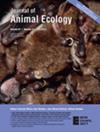The clockwork of insect activity: Advancing ecological understanding through automation
IF 3.5
1区 环境科学与生态学
Q1 ECOLOGY
引用次数: 0
Abstract

昆虫活动的发条:通过自动化推进生态认识。
了解昆虫行为及其潜在驱动因素对于解释当地生物多样性的变化和预测未来趋势至关重要。传统的捕虫器通常仅限于评估较长时间内当地昆虫群落的组成,并且只能提供有限的非生物因素(如光对物种活动的影响)的见解。实现更精细的时间分辨率是劳动密集型的,或者只能在实验室条件下实现。在这里,我们证明了使用自动萎靡陷阱和元条形码相结合的时间控制昆虫采样可以观察和记录分类群特定的活动模式。此外,这些记录的活动模式可以为潜在的生态过程提供有价值的见解。利用广义线性潜变量模型,从预测检出数得到昆虫活动曲线,揭示了昆虫活动模式在高、低分类水平上的显著差异。虽然我们的发现与现有文献一致,但它们也揭示了一些物种的活动模式比以前所知的更复杂。此外,对不同分类群的评估活动模式的比较表明,潜在的、以前未被描述的寄主与寄生虫的关系。在分类群体中,我们观察到活动模式的时间和持续时间的变化,这可能与密切相关物种之间交配策略的差异有关。通过时间控制的批量采样捕捉昆虫活动的昼夜节律,我们可以扩展我们对物种行为、生态和时间相互作用的知识。这极大地促进了时间生态学的发展,使我们能够进一步探索物种在自然和人为生态系统中的作用和利益,以及它们潜在的重大威胁。
本文章由计算机程序翻译,如有差异,请以英文原文为准。
求助全文
约1分钟内获得全文
求助全文
来源期刊

Journal of Animal Ecology
环境科学-动物学
CiteScore
9.10
自引率
4.20%
发文量
188
审稿时长
3 months
期刊介绍:
Journal of Animal Ecology publishes the best original research on all aspects of animal ecology, ranging from the molecular to the ecosystem level. These may be field, laboratory and theoretical studies utilising terrestrial, freshwater or marine systems.
 求助内容:
求助内容: 应助结果提醒方式:
应助结果提醒方式:


